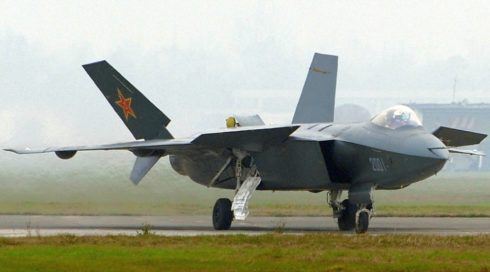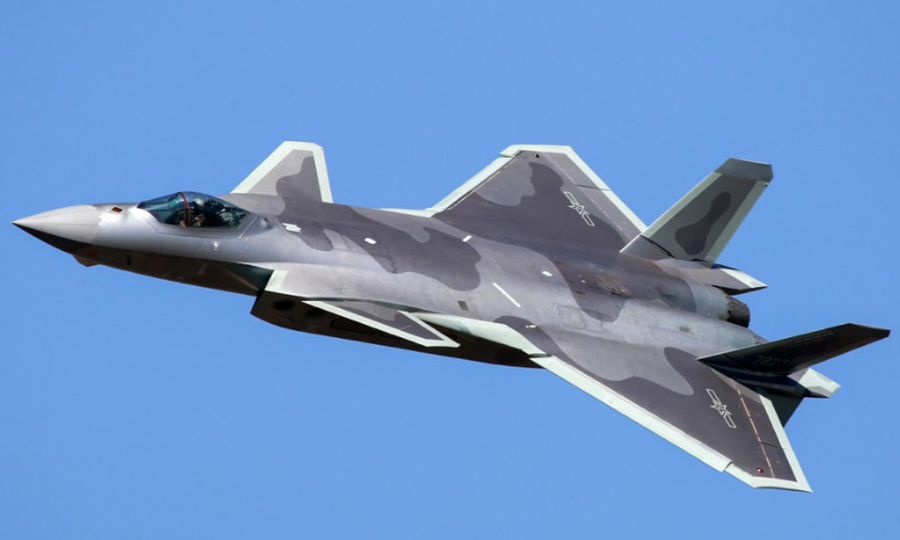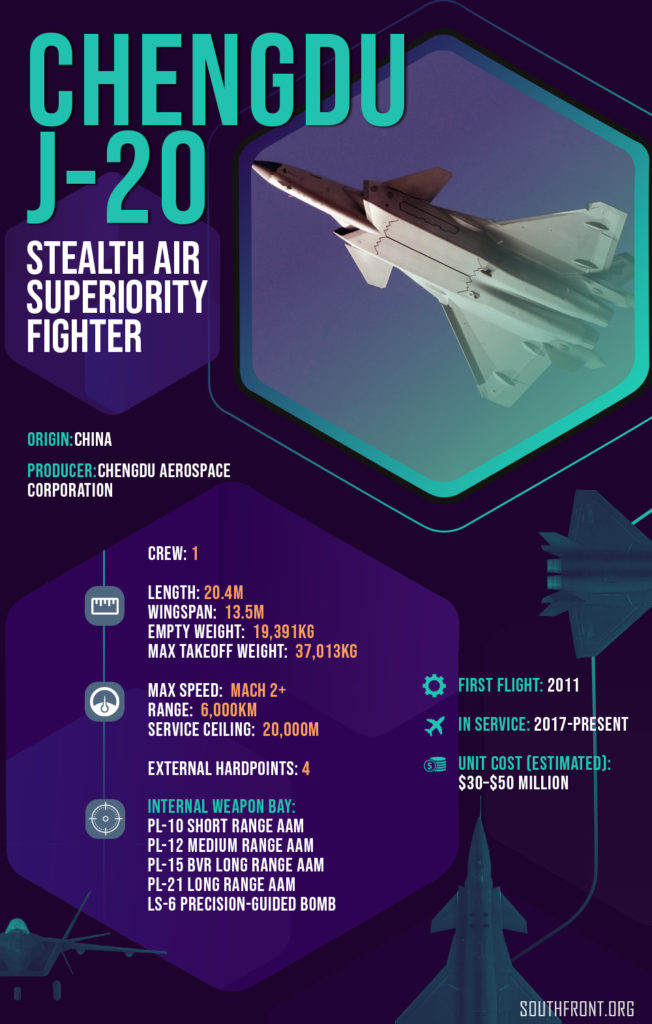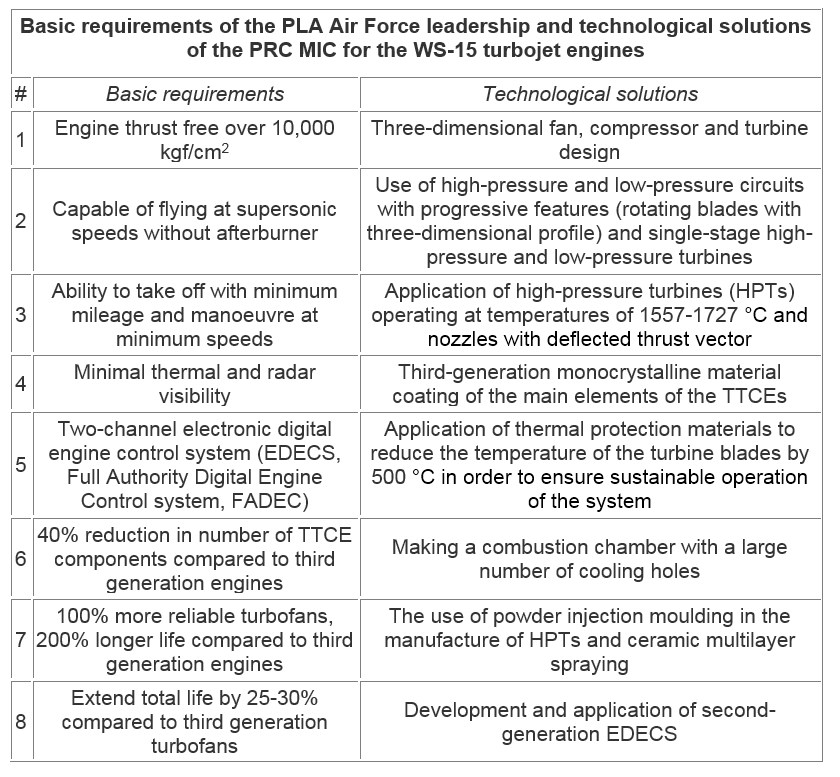Written by Captain 2nd Rank A. Kirovets, Lieutenant Colonel A. Timofeev; Originally appeared at Foreign Military Review 2021 #1, translated by AlexD exclusively for SouthFront
The military-industrial complex of China demonstrates its ability to produce modern military equipment. One of the priority areas in this area is the development and production of fifth-generation tactical fighters (TF).
Aircraft of this generation must have a number of the following important characteristics: small size of the effective stealth area (0.6 m2, ESA), supermaneuvrability, flight at supersonic speeds without the use of afterburner mode and versatility.
In this regard, the independent development of such aircraft is possible only for states with a developed military-industrial complex.
A significant achievement of the Chinese military industry was the adoption of the Chengdu J-20 TF, which allowed the PRC to become the third country after the United States and the Russian Federation to produce the fifth-generation TF.
The Chengdu J-20 tactical fighter is designed to gain and maintain air superiority. Its main tasks are conducting close and long-range air combat, solving air defence tasks, as well as hitting ground and surface targets. In order to effectively use the fighter, the military-industrial complex of the People’s Republic of China has developed appropriate avionics, as well as a wide range of weapons, including guided missiles, adjustable and free-falling aircraft bombs.
The aircraft was created by the 611th Research Aviation Institute (Changdu Aviation Industry Group). Pre-production started at the aircraft manufacturing plant of the Aviation Industrial Corporation in Chengdu (prov. Sichuan). The cost of research and development work (R&D) during the development of the Chengdu J-20 fighter was $5.8 billion (US), and the price of one aircraft was $39 million (for comparison, the fifth-generation F-22A Raptor fighter, $146 million, the Russian Su-57, $34.5 million).
Within the framework of R&D, eight Chengdu J-20 aircraft were built. The first prototype made a test flight on January 11, 2011. The fighter worked out technical and design solutions for the aerodynamic layout and reducing the visibility of the aircraft. The second, made a test flight in June, during which tests of avionics, hydraulic, pneumatic and pyrotechnic systems, including the pilot ejection system, were carried out.
The third and fourth prototypes did not participate in flight tests, as they were intended to test the reliability of the functioning of the aircraft components and assemblies under the influence of static, dynamic and shock loads.
The remainder were used to refine systems and design features that had shown unsatisfactory performance.
In the course of these R&D activities, a number of design flaws were identified, a decision was taken to produce the second batch of experimental machines, testing of which began in February 2014.
The design of the fighters of this series had a number of significant differences from the previous machines: The following components and assemblies were changed:
- the location of the sensors, presumably the crew’s air situation awareness system (1 and 2);
- added a power arc under the glazed glass canopy (3);
- section of the air intake profile (4);
- location of process hatches (5 and 13);
- geometry of the rear edges of the wingtips and the vertical tail (6 and 10);
- geometry of the horizontal tail and sub-fuselage ridges beneath it (7, 8, 9);
- geometry of the fins of the edges of the armament compartments and landing gear flaps (11);
- an opto-electronic system for detecting ground and surface targets was installed in the nose of the fuselage and on the outer surface of the air intakes (12 and 14).
The Chengdu J-20 fighter is a high-flying duck-type airframe with a triangular wing with overhangs, front horizontal and vertical twin-winged fins with under-fuselage crests, equipped with two turbojet engines. The landing gear has three supports: the front wheel which retracts forward, the main struts retract into the side bays (similar to the F-22 fighter), indicating the location of the weapons bay in the centre of the aircraft’s hull.
The fuselage sides of the fighter have the same tilt angle as the one-piece vertical stabilisers, and the outline of the front end is typical of low-ESA fighters.
The aerial refuelling system is retractable in the interest of reducing visibility and improving the aerodynamic performance of the craft. The fuel intake is located on the right side of the cockpit.
During the construction of the fighter, composite materials with modified crystal lattice structure were used extensively to obtain new properties. Thus, in order to reduce the aircraft’s ESA (estimated at around 0.6 m2), part of the antenna devices was made of resonant meta-materials, whose dielectric permittivity occurs only at a certain radiation frequency. The cockpit canopy is designed with an interlaced design that enhances the pilot’s view. The cockpit is designed according to the HOTAS (Hands-On Throttle and Stick) concept. The concept implies that the pilot engages virtually all avionics and weapons functions without removing his hands from the main controls of the aircraft. The design feature of the cockpit is the uncharacteristic right-handed position of the control stick on China’s combat aviation.
During the tests, pilots used the TK-31 flight helmet, which has improved ergonomics and reduced weight. However, a new high-tech helmet was used when operating the production machines. It is believed to be the analogue of BAE Systems’ (UK) Striker II HMD helmet. A design feature of the helmet is an LCD screen mounted on the face shield (HMD – Helmet Mounted Display). Depending on the selected glass polarisation mode, the faceplate can be completely transparent or act as a monitor to which images from cameras mounted on the aircraft’s fuselage are transmitted. This allows visual inspection of enemy fighters and missiles in the lower hemisphere, and also improves visibility, as elements of the cockpit equipment do not enter the pilot’s field of vision. The helmet is capable of operating in night vision mode.
In addition, its hardware includes a target designation system for guided airborne weapons.
The Chengdu J-20 tactical fighters of the first and second experimental series are equipped with third-generation AL-31F M2 turbojet twin-circuit engines (TTCE engines) manufactured in the Russian Federation.
The production machines will be fitted with the Chinese-made WS-10 TTCE, which features a single high-pressure turbine, dual low-pressure turbine, annular combustion chambers and compressors. The engine is planned to be produced in three modifications:
- WS-10A – with increased thrust;
- WS-10B – with increased service life;
- WS-10G – with 155 kN thrust and controlled thrust vector.
In order to enhance the combat capabilities of the Chengdu J-20, China’s military-industrial complex research institutes and production organisations are developing the fourth-generation WS-15 steerable thrust vector aircraft engine (codenamed Emei). In developing this aircraft engine, PLA Air Force specialists have set technical requirements that will surpass the performance of the F-119 turbofan engine (made in the USA) installed on the F-22A Raptor fighters.
The problem of turbine blade overheating was solved during the development of the WS-15 turbofan engine by coating the working surfaces with high-temperature ceramic metal allows (HTCM) using rhenium, tantalum and niobium. According to the Chinese research institute, application of two or three coats of the HTCM decreases blade temperature by 200-300 °C. In China, however, single-crystal alloys are being created without rhenium because of the high cost of this rare-earth mineral.
However, until work on the WS-15 aircraft engine is completed and its serial production begins, the Chengdu J-20 will be equipped with the WS-10 turbojet engine, which adversely affects the aircraft’s flight and performance characteristics and increases its visibility. The Chengdu J-20 in service with the PLA Air Force currently has a maneuverability rating of more than 15 percent behind similar foreign aircraft such as the F-22.
In order to effectively utilise fifth-generation aircraft, the leadership has decided to create new types of avionics equipment for the PLA Air Force combat aircraft, including radar stations (radars). The China Electronics Technology Group Corporation’s 14 R&D institutes have developed the KLJ-5 (type 1475) active phased array radar (APAR), which is mounted on the Chengdu J-20. The number of APAR receiving and transmitting modules is 1,856.
The mock-up of the advanced KLJ-7A radar was presented at the 2016 China Airshow by the Nanjing Research Institute of Electronic Technology.
The radar station is an improved version of the KLJ-7 (type 1478) radar. It operates in the 3 cm frequency band and provides fighter-type target detection with a range of up to 170 km, tracking up to 15 and tracking up to 4 targets simultaneously, and has 11 modes of operation, including terrain mapping.
The PLA AF has developed the EO-DAS MAWS (Electronic-Optical Distributed Aperture System Missile Approach Warning System) to enhance the protection of PLA AF aircraft against anti-aircraft guided missiles (SAMs) launched by potential adversaries. The system consists of a set of combined infrared and ultraviolet range optronic sensors mounted on the aircraft’s fuselage and computing units built into the avionics suite on a modular basis.
The main functions of the system are:
- monitoring of the aerial situation and providing situational awareness to the crew;
- all-angle (360°) detection of attacking SAMs, including fixing their launch points and transmitting information about them to the pilot;
- tracking other airborne objects including aircraft, ballistic missiles and cruise missiles, and transmitting information about them to the pilot.
The guaranteed maximum detection range of a SAM is 9.3 km. Other airborne targets such as ballistic missiles, aircraft (especially military transport aircraft) can be detected at ranges of up to 100 km (depending on target visibility and weather conditions). The optronic sensors are also capable of transmitting information about ground conditions (blast detection, large-calibre gunfire, fires, high visibility targets and those that contrast with the underlying surface).
The Chengdu J-20 fighter’s avionics equipment includes a Luneberg lens reflector* located near the left main landing gear strut. The device is designed to increase the aircraft’s radar visibility in the interest of misleading a likely adversary about the aircraft’s true ESA, as well as improving the safety of joint flights and better interaction with air traffic controllers. The lens is initially intended to be operated in peacetime only, with the option of removal during combat missions.
To enhance the Chengdu J-20 fighter’s ability to strike ground and surface targets, Jiangsu A-Star Aviation Industries developed the EOTS-86 optronic reconnaissance and guidance station.
The sensor receiver is covered by a sapphire crystal. The station also includes computing units and a laser rangefinder with target designation function (TDF).
The station is interfaced to the EO-DAS MAWS system and is designed for the following tasks:
- providing situational awareness to the pilot of the air and ground situation;
- aerial reconnaissance with photo and video recording;
- detection of ground, surface and air targets with low visibility against the underlying surface;
- tracking and automatic tracking of detected targets, range measurement and TDF illumination;
- targeting infrared and laser-guided heads (LGH) or transmitting target data to other aircraft, including previous generations, for the effective use of their air-to-ground weapons.
According to PLA AF requirements, this equipment should detect bomber-class aerial targets at a range of 150 km, destroyer-class surface targets at 80 km and tank-type ground targets at 25 km.
The particularity of using the system is to keep the aircraft low-visibility. This is achieved by the presence of highly sensitive passive sensors, the absence of active radiation from the airborne radar and the low intensity of the TDF radiation when illuminating targets.
Compared to its counterpart on the F-35 tactical fighter, the EOTS-86 system has a more limited field of view, centred on the aircraft’s forward hemisphere.
In addition to the EOTS-86 optronic reconnaissance and guidance station, the tactical fighter is to be fitted with the Jiangsu A-Star Aircraft Industries’ EORD-31 forward-looking infrared search and tracking system. This equipment is based on the Russian OTS-27, which was supplied as part of the Su-27 fighter jets equipment. The main difference is that the system’s cowling is not spherical, but faceted, which should have a positive effect on the aerodynamic performance of the aircraft.
The missile armament of the Chengdu J-20 is located in the main and two side fuselage compartments, there are also four external armament hanger points on the wing consoles and two on the fuselage side walls, but their use significantly increases the fighter’s visibility.
The main fuselage compartment is used to house air-to-air missiles. Its dimensions are 4.5 x 2.2 m. Four long-range missiles or six medium-range and short-range missiles can be staggered together. Each side fuselage compartment houses one shorter-range missiles.
Four outboard fuel tanks of 2,400 litres each can be installed on the aircraft’s external sling assemblies to increase the combat range or ferry range.
The Chengdu J-20 fighter is armed with China-made Pili-21 long-range, Pili-15 and Pili-12 medium-range, and Pili-10 short-range air-to-air guided missiles. In addition, other types of missiles and aerial bombs are to be used against ground and surface targets.
The Pili-21 rocket is equipped with a ramjet engine and a high-explosive propellant warhead.

Illustrative image
This missile is used by the fourth and fifth generation fighters. It is equipped with a combined guidance system: a radio command system at the beginning of the trajectory and an active one at the end (after the missile’s radar homing head detects and captures the target).
The Pili-15 medium-range air-to-air missile, developed by 607 Institute of Aircraft Corporation of China, is equipped with a combined guidance system that includes an inertial guidance system as well as a radar and infrared channel seeker.
The first test launch of the Pili-12 missile took place in mid-2002 aboard a Su-30 MKK fighter of the PLA Air Force. The missile is in service with the third- and fourth-generation aircraft of the Chinese and Pakistani Air Forces.
In 2018, the Pili-12 missile was upgraded specifically for the Chengdu J-20 fighter to the Pili-12C variant.
The latter differs from the basic version in that it has folding rudders and can be housed both externally and in the aircraft’s fuselage bays. The export version of the ammunition is marked SD-10.
The missile was developed with the technical assistance of Russian specialists and is an analogue of the Russian R-77 medium-range ballistic missile. Structurally, it has a normal aerodynamic design with a cruciform triangular wing and trapezoidal all-pivot stabilisers. The product consists of: LGH, a warhead with a firing mechanism and an active laser non-contact fuse, a control unit, steering gears, and a dual-mode solid rocket motor with automatic (depending on target range) control of the duration and thrust. To increase the range, a hinged trajectory launch is possible.
At the 2016 China Airshow, the Shanghai Academy of Science and Technology unveiled a modification of this missile called Pili-10E. The missile is equipped with a multi-element infrared guidance system with glare protection and is capable of engaging targets that are away from the line of sight.
The missile armament may also include the Yingzi 91 anti-radar missile, developed and manufactured by the Hungdu Aviation Industry Corporation (PRC).
The missile is designed to destroy enemy ground-based radars by targeting their emissions. This anti-radar missile is based on the Russian X-31P missile supplied to the PLA Air Force, for which reason they have a similar design and tactical and technical characteristics.
After testing in 2009, the developed bomb was designated LS-6-500 and adopted by the PLA Air Force.
In addition, depending on the characteristics and conditions of the mission, the Chengdu J-20 tactical fighter can use missiles of different classes and types (including anti-ship missiles) previously developed and adopted for service with the PLA Air Force and Navy, unguided aerial bombs, unguided rocket launchers, outboard containers with electronic warfare and reconnaissance equipment.
Thus, the Chengdu J-20 fifth-generation tactical fighter has implemented the principle of multifunctionality, as the combination of aircraft flight characteristics, composition and performance parameters of its avionics, the range of weapons used and the equipment used allow the pilot to effectively perform air combat at all ranges, air defence, as well as strikes against ground and surface targets.
*A lens reflector is a spherical multi-layer dielectric material with different dielectric values. This ensures that a beam of electromagnetic waves incident on it is focused to a single surface point on the sphere.










That’s an awful lot of information. . . good if one is technically inclined about jet fighter aircraft.
I don’t think J-20 is multi-role jet fighter with emphasis on “air superiority”. It looks more like long range strike (and multi role) fighter.
“…the price of one aircraft was $39 million (for comparison, the fifth-generation F-22A Raptor fighter, $146 million, the Russian Su-57, $34.5 million).”
That’s because Russia and China are working to produce actual aeroplanes, not boondoggles.
China has the tech and industrial infrastructure to make quantum leaps in any industry. It now has cornered the market on innovation and R&D as well. The commercialization of education in the US and the west in general has turned it into rich brats club who are neither brainy or canny. The US is slipping faster than a slippery slope.
su57 is a 4.5 generation aircraft
Primarily role I’d suggest would be for knocking out tankers, AWACS, strategic transport and ELINT, AGS/ISTAR high value targets.
Look at the guns on that bird.
Like the Chinese, it’s a workhorse.
Does it also shoot itself in the head?
https://www.aerotime.aero/27533-us-marine-f-35-shoots-itself-friendly-fire
Frankly, America thanks to endless warmongering and domestic meltdown losing the future to China
If US inattention to R&D continues to abet China’s rise to high-tech dominance, Beijing’s military threat will grow as well. China today is the globe’s only true superpower and its high tech dominance is growing by the day.
China ha become the world’s premier economy and world power, in large part because of Beijing’s consistent investment in high-tech innovation spear headed by the largest pool of highly educated hard sciences and engineering graduates. .
Whether it be artificial intelligence or space technology, China is rapidly becoming a dominant player in high-tech development. As these trends intensify over the next decade, China’s military threat to the United States will naturally increase as well. The Chinese J-10 and J-16 are also top of the line formidable front-line aircraft. The sheer scale of China’s industrial output combined with technology and endless fiscal resources ensures that it can produce any weapons systems in large numbers in the shortest time.
btw., china wants siberia and not alaska
China is not a expansionist power. It uses soft power as its $600 billion trade, economic and defence deal has clearly shown. Russia is a medium population nation with a large resources rich landmass contiguous to China, so Chinese influence is a given.
CHINA SPREADS SOFT POWER ACROSS EURASIA
The landmark accord identifies Iran as a large, resource rich independent nation and also brings Iran into the grasp of Beijing’s Belt and Road infrastructure scheme – an ambitious scheme worth the equivalent of over$1 trillion aiming to link China to Europe and Africa via a series of new land- and sea-based infrastructure projects across dozens of nations.
toy